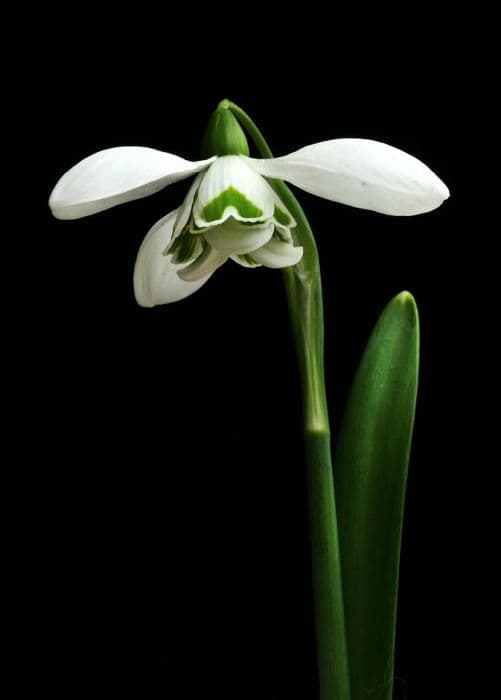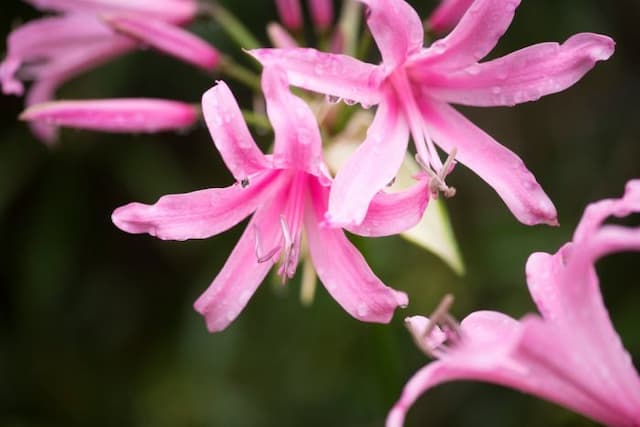Snowdrop Galanthus 'Barbara's Double' (d)

ABOUT
Galanthus 'Barbara's Double', commonly known as the double snowdrop, is a charming and distinctive variant of the classic snowdrop flower. What sets 'Barbara's Double' apart is its unique flower form. Unlike the single drooping bell-like blooms of the traditional snowdrop, this cultivar has additional petals, giving the flowers a fuller, double-flowered appearance that resembles a small bouquet hanging from each stem. The petals of the double snowdrop are pristine white, a characteristic shared with its relatives. However, inside the outer petals lies a ruffle of inner segments, often adorned with green markings. These green markings can vary from simple dots to more intricate bridges or X-shaped patterns, adding an elegant contrast to the otherwise snowy whiteness of the petals. The leaves of the plant are slender, and arching, with a dark green color that provides a lovely backdrop to the delicate flowers. The foliage gracefully frames the flowers, creating an attractive contrast between the green leaves and the white petals. 'Double' forms of snowdrops like 'Barbara's Double' are especially coveted by garden enthusiasts and collectors for their ornate and uncommon blossoms that provide an early touch of beauty in late winter to early spring landscapes.
About this plant
 Names
NamesFamily
Amaryllidaceae
Synonyms
Double Snowdrop, Barbara's Double Snowdrop
Common names
Galanthus 'Barbara's Double'
 Toxicity
ToxicityTo humans
Snowdrop varieties, including Galanthus 'Barbara's Double', contain alkaloids such as galantamine which can be toxic if consumed by humans. Ingesting parts of the plant can lead to symptoms such as gastrointestinal upset, nausea, vomiting, diarrhea, and in severe cases, it can affect the nervous system. Handling the plant may also cause skin irritation.
To pets
Snowdrop toxicity applies to pets as well. If pets ingest parts of a snowdrop plant, they might experience vomiting, diarrhea, abdominal pain, and lethargy. Severe cases of poisoning could potentially lead to more serious nervous system effects or cardiovascular problems. It is important to ensure that pets do not consume any part of the plant.
 Characteristics
CharacteristicsLife cycle
Perennials
Foliage type
Deciduous
Color of leaves
Green
Flower color
White
Height
6-9 inches (15-23 cm)
Spread
3-6 inches (7-15 cm)
Plant type
Bulb
Hardiness zones
3-8
Native area
Europe
Benefits
 General Benefits
General Benefits- Aesthetic Appeal - Galanthus 'Barbara's Double', commonly known as double snowdrop, has unique and attractive double-flowers that enhance the visual interest of any garden.
- Early Bloomer - Double snowdrops are one of the first plants to bloom in late winter or early spring, bringing color to the garden after the winter months.
- Pollinator Friendly - The blooms provide an early source of nectar for bees and other pollinators emerging in the spring.
- Low Maintenance - Once established, snowdrops require minimal care and can thrive in many soil types and conditions.
- Naturalizing - They have the ability to naturalize, or spread, over time to create drifts or carpets of flowers in the landscape.
- Cold Hardy - Double snowdrops are resilient to cold temperatures and can survive freezing weather, making them suitable for cooler climates.
- Versatility - They can be planted in a variety of settings, including borders, under trees, and in lawns for a springtime meadow effect.
 Medical Properties
Medical PropertiesThis plant is not used for medical purposes.
 Air-purifying Qualities
Air-purifying QualitiesThis plant is not specifically known for air purifying qualities.
 Other Uses
Other Uses- Symbol of Hope: Galanthus 'Barbara's Double' can be used in arrangements or garden designs as a symbol of hope and the coming of spring, since it is one of the first plants to bloom at the end of winter.
- Indicator of Climate Change: Scientists sometimes track the blooming patterns of Galanthus to study the effects of climate change on the timing of seasonal events in plants.
- Art and Photography: The unique double blooms of Galanthus 'Barbara's Double' make it a stunning subject for botanical art and photography projects, capturing the intricate detail of its flowers.
- Cold Storage Testing: The plant’s ability to withstand cold before blooming can be used as a bio-indicator in research on cold storage for horticulture.
- Bee Forage: As one of the early sources of nectar and pollen, Galanthus 'Barbara's Double' is used to provide forage for bees when there is little else in bloom.
- Collector's Item: Due to its rarity, this particular cultivar of Galanthus can be cultivated and traded among garden enthusiasts and collectors.
- Winter Gardens: This plant is ideal for creating winter interest in gardens, as it blooms when most other plants are dormant.
- Eco-Tourism: Galanthus 'Barbara's Double' can draw visitors to gardens and natural areas for 'snowdrop festivals' and other eco-tourism events celebrating early spring flowers.
- Floral Language and Messages: In the language of flowers, Galanthus can be used to convey a message of consolation or hope, making it a thoughtful component of bouquets for certain occasions.
- Educational Tool: Galanthus 'Barbara's Double' can be included in educational programs about plant biology, particularly about bulb growth and development.
Interesting Facts
 Feng Shui
Feng ShuiSnowdrop is not used in Feng Shui practice.
 Zodiac Sign Compitability
Zodiac Sign CompitabilitySnowdrop is not used in astrology practice.
 Plant Symbolism
Plant Symbolism- Hope: As one of the first flowers to emerge in late winter, the snowdrop symbolizes hope and the promise of new beginnings.
- Purity: The snowdrop's white color is often associated with purity and innocence.
- Consolation or Comfort: Snowdrops can also represent sympathy, offering comfort to those who have experienced loss.
- Resilience: These flowers push through the snow, symbolizing resilience and the ability to overcome challenges.
 Water
WaterThe Snowdrop, specifically Galanthus 'Barbara's Double', requires consistent moisture during its flowering period in late winter and early spring. It is essential to water the Snowdrop when the top inch of soil feels dry, which could be approximately once a week depending on climate conditions. It is best to use a gentle watering method, such as a watering can with a fine spout, to avoid disturbing the delicate flowers or compacting the soil. Typically, giving the plant about one to two gallons of water every week will maintain the appropriate moisture level without waterlogging the soil, which can be detrimental.
 Light
LightSnowdrops, including Galanthus 'Barbara's Double', thrive in dappled sunlight or partial shade, making them perfect for planting under deciduous trees or shrubs that will shade them in summer but allow full sunlight in winter. They can also be positioned on the north or east side of a building, where they receive morning light and are protected from the intense afternoon sun. Avoid placing Snowdrops in deep shade, as this can lead to poor flowering.
 Temperature
TemperatureSnowdrops, such as Galanthus 'Barbara's Double', prefer cool temperatures and are hardy in the range of 10°F to 75°F, which makes them well-suited to temperate climates. The bulbs can survive winter chills down to about 10°F and can manage in temperatures up to about 75°F when dormant in summer. The ideal temperature range for active growth and flowering is between 35°F and 53°F.
 Pruning
PruningPruning is not typically required for Snowdrops, such as Galanthus 'Barbara's Double', since they are small, bulbous plants. However, after flowering, it's beneficial to remove spent flower heads to tidy up the plant and prevent self-seeding if desired. It's best to leave the foliage until it naturally dies back, which allows the plant to gather energy for next season's blooms.
 Cleaning
CleaningNot needed
 Soil
SoilSnowdrops like well-drained soil rich in organic matter with a pH of 6.5 to 7.5. Incorporate compost or leaf mold to improve soil structure and fertility.
 Repotting
RepottingSnowdrops typically do not require frequent repotting and can thrive undisturbed for several years. Repot if overcrowding occurs.
 Humidity & Misting
Humidity & MistingSnowdrops prefer outdoor conditions with natural humidity and do not have specific humidity requirements for healthy growth.
 Suitable locations
Suitable locationsIndoor
Plant in well-draining soil, bright light, and cool temperature.
Outdoor
Plant in partial shade, well-drained soil; mulch seasonally.
Hardiness zone
3-9 USDA
 Life cycle
Life cycleThe Galanthus 'Barbara's Double', commonly known as a type of double snowdrop, begins its life cycle as a bulb, which remains dormant underground during the summer. As temperatures cool in late autumn, the bulb breaks dormancy and roots begin to grow. In late winter or early spring, depending on the climate, the bulb sends up shoots that lead to the development of the plant's distinctive double white flowers, often while snow is still on the ground. After flowering, the plant produces leaves that photosynthesize to replenish the bulb's energy reserves. By late spring, the above-ground foliage dies back and the plant enters a period of dormancy once more, with the cycle repeating the following year. Seed production is possible but less common, and when it occurs, seeds develop and disperse near the parent plant, which can lead to new bulb formation and gradual spread of the species.
 Propogation
PropogationPropogation time
Spring-Early Summer
The most popular method for propagating Galanthus 'Barbara's Double', commonly known as double snowdrop, is by dividing its bulbs. This should be done when the plant is dormant, typically after the leaves have withered which is in late spring to early summer. To divide snowdrop bulbs, carefully lift the clump from the soil using a garden fork, ensuring minimal damage to the bulbs. Then, gently pull apart the bulbs at their natural division points. Smaller bulbs should be replanted immediately at a depth of about 3 inches (approximately 7.6 centimeters) while keeping a spacing of around 3 to 4 inches (about 7.6 to 10 centimeters) apart, in a location with well-drained soil and partial to full shade. Water the new plantings moderately to help establish a strong root system. Over time, these bulbs will multiply, creating a fuller display of blossoms each spring.









